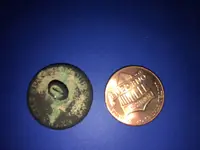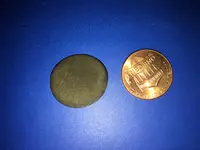You are using an out of date browser. It may not display this or other websites correctly.
You should upgrade or use an alternative browser.
You should upgrade or use an alternative browser.
A button - this much I know
- Thread starter thedukeofdelaware
- Start date
grasshopper
Bronze Member
- Joined
- Aug 13, 2007
- Messages
- 1,895
- Reaction score
- 2,973
- Golden Thread
- 1
- Location
- Upstate NY
- 🥇 Banner finds
- 1
- Detector(s) used
- XP Deus/Deus 2
- Primary Interest:
- All Treasure Hunting
These flat buttons had all kinds of quality designations (extra rich superior gold gilt orange plated super fine treble, etc)...i've found hundreds with different combinations of descriptions.
Probably a civilian button from 1800-1830ish
Copied from another thread: (I can't remember who wrote this, sorry for stealing )
)
The "plain front" brass 1-piece flatbuttons in the photo were manufactured for use on civilian clothing. Ones with a raised-lettering backmark date from approximately 1790 to the very-early-1840s, and ones with indented backmarking start about 1810.
The majority of the brass 1-piece flatbuttons we dig in the US were imported here from Britain, because until the mid-1820s the young US button-making industry was incapable of mass-producing them, falling far short of the demand-level from the Clothing-Manufacturers. Therefore, in the early-1800s, many millions of the plain-front brass 1-piece buttons were still being imported from the old "Mother Country," Britain.
The War-Of-1812 caused US consumers to dislike British-made products, so American button-makers sometimes included an American eagle in the button's backmark to signify that it was a US-made button. (British-made ones often have a British crown in the backmark.)
At that time, the word gilt in a button's backmark referred strictly to gold-plating... and the word plated meant silver-plating.
Also at that time, the British had established a set of "Quality" standards regarding the manufacture of metal buttons. Unfortunately, the standards were not strictly enforced, so button makers quickly went to playing fast-and-loose with the Quality ratings. I should mention, the American button manufacturers copied the British markings. So unless a backmark tells a British location (like London) or contains a British spelling (such as "colour" instead of color, a quality-rating in the backmark won't tell you whether the button is British-made or US-made. Some of the many examples of "Quality-Rating" in backmarks are: Standard Quality Extra Quality Fine Quality Superior Quality Best Quality Superfine Quality Gilt Extra Gilt Fine Gilt Treble Gilt "Orange Colour" (refers to the color of the goldplating) Rich Orange Plated Treble Plated
Probably a civilian button from 1800-1830ish
Copied from another thread: (I can't remember who wrote this, sorry for stealing
 )
)The "plain front" brass 1-piece flatbuttons in the photo were manufactured for use on civilian clothing. Ones with a raised-lettering backmark date from approximately 1790 to the very-early-1840s, and ones with indented backmarking start about 1810.
The majority of the brass 1-piece flatbuttons we dig in the US were imported here from Britain, because until the mid-1820s the young US button-making industry was incapable of mass-producing them, falling far short of the demand-level from the Clothing-Manufacturers. Therefore, in the early-1800s, many millions of the plain-front brass 1-piece buttons were still being imported from the old "Mother Country," Britain.
The War-Of-1812 caused US consumers to dislike British-made products, so American button-makers sometimes included an American eagle in the button's backmark to signify that it was a US-made button. (British-made ones often have a British crown in the backmark.)
At that time, the word gilt in a button's backmark referred strictly to gold-plating... and the word plated meant silver-plating.
Also at that time, the British had established a set of "Quality" standards regarding the manufacture of metal buttons. Unfortunately, the standards were not strictly enforced, so button makers quickly went to playing fast-and-loose with the Quality ratings. I should mention, the American button manufacturers copied the British markings. So unless a backmark tells a British location (like London) or contains a British spelling (such as "colour" instead of color, a quality-rating in the backmark won't tell you whether the button is British-made or US-made. Some of the many examples of "Quality-Rating" in backmarks are: Standard Quality Extra Quality Fine Quality Superior Quality Best Quality Superfine Quality Gilt Extra Gilt Fine Gilt Treble Gilt "Orange Colour" (refers to the color of the goldplating) Rich Orange Plated Treble Plated
Last edited:
Upvote
0
nhbenz
Gold Member
- Joined
- Dec 30, 2004
- Messages
- 6,821
- Reaction score
- 6,848
- Golden Thread
- 0
- Location
- Brentwood, NH
- Detector(s) used
- White's Classic SL
White's Surf P.I.
That was by TheCannonballGuy in this thread, just to give credit where due: http://www.treasurenet.com/forums/w...iasts-help-id-age-other-button-resources.html
Upvote
0
grasshopper
Bronze Member
- Joined
- Aug 13, 2007
- Messages
- 1,895
- Reaction score
- 2,973
- Golden Thread
- 1
- Location
- Upstate NY
- 🥇 Banner finds
- 1
- Detector(s) used
- XP Deus/Deus 2
- Primary Interest:
- All Treasure Hunting
Thanks! I had copied it to my desktop and couldn't remember where I found it. As always thanks CBG for your knowledge [emoji3]That was by TheCannonballGuy in this thread, just to give credit where due: http://www.treasurenet.com/forums/w...iasts-help-id-age-other-button-resources.html
Sent from my SM-G935V using TreasureNet.com mobile app
Upvote
0
nhbenz
Gold Member
- Joined
- Dec 30, 2004
- Messages
- 6,821
- Reaction score
- 6,848
- Golden Thread
- 0
- Location
- Brentwood, NH
- Detector(s) used
- White's Classic SL
White's Surf P.I.
Indeed, this is from him as well:
EA&S is Edward Armfield & Son, of Birmingham, England. Listed as a button-maker from 1805 to 1860. Your button's typic British "Quality" marking supports that identification. By the way, the E. Armfield & Son backmark is on an 1816-era 1-piece brass Massachusetts Independent Corps of Cadets button, listed as MS60A in the Albert button book. So, all things considered, I believe the statistical odds favor your button having been made sometime between 1815 (just after the US-versus-Britain War of 1812 ended) and approximately 1830 (when US-made buttons became cheaper than imported British-made buttons).
That was from this thread:
http://www.treasurenet.com/forums/what/279711-back-mark-help.html
EA&S is Edward Armfield & Son, of Birmingham, England. Listed as a button-maker from 1805 to 1860. Your button's typic British "Quality" marking supports that identification. By the way, the E. Armfield & Son backmark is on an 1816-era 1-piece brass Massachusetts Independent Corps of Cadets button, listed as MS60A in the Albert button book. So, all things considered, I believe the statistical odds favor your button having been made sometime between 1815 (just after the US-versus-Britain War of 1812 ended) and approximately 1830 (when US-made buttons became cheaper than imported British-made buttons).
That was from this thread:
http://www.treasurenet.com/forums/what/279711-back-mark-help.html
Last edited:
Upvote
0
Similar threads
- Suggestion
- Replies
- 16
- Views
- 430
- Replies
- 16
- Views
- 883
- Replies
- 5
- Views
- 362
Users who are viewing this thread
Total: 1 (members: 0, guests: 1)





